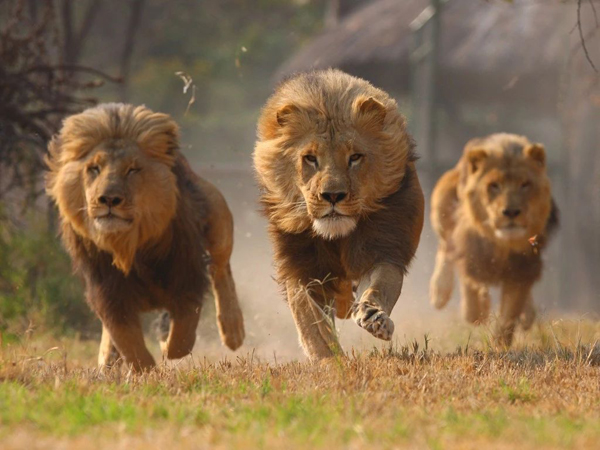The Asiatic lion is the smallest of all lion subspecies, with a body length of 1.2-1.7 meters, a male lion weighing 150-200 kilograms, and a female lion weighing 90-150 kilograms. The longest male lion on scientific record is 292 centimeters long, with a shoulder height of up to 139 centimeters. Although the male Asiatic lion also has a long mane on its neck, it is significantly shorter than that of the African male lion. It also has a small amount of long hair on the elbows of its forelimbs, and its fur is fluffier than that of its African relatives, and the hair on the end of its tail is larger. The male Asiatic lion has less mane on its neck than the African lion, and the hair on the end of its tail is also larger, with thicker back hair and fuller body hair. The cubs have spots, and their fur is mainly brown and yellow. Both male and female lions have obvious folds of skin on their abdomens.
Details
The Asiatic Lion (scientific name: Panthera leo persica) is a subspecies of lion that now only survives in India. They were once distributed from the Mediterranean to India, occupying most of Southwest Asia, so it is called the "Persian subspecies".

In India, the Asiatic lion is the animal most closely associated with religion and royal power. In Sanskrit, the lion is called sanghapi, which means "monks". As the symbolic animal of the Buddha Shakyamuni, there are descriptions of lions in the Buddhist scriptures "Nirvana Sutra" and "Great Wisdom Theory". The Asiatic lion is also a symbol of royal dignity and power. In the 3rd century BC, Emperor Ashoka of the Maurya Dynasty once carved the image of a lion on a stone pillar in Sharlant (one of the most important Buddhist relics in India, where Sakyamuni first preached to his disciples in the Bamboo Grove of Sharlant). The purpose was to promote the life message of non-violence, tolerance and respect. Ashoka may be one of the earliest rulers to promote the concept of animal protection. In the early 21st century, the pattern on the national emblem of the Republic of India was taken from the Asiatic lion on Ashoka's stone pillar.
Asiatic lions like to live in groups and often hunt collectively, but most of the time it is female lions who hunt, and male lions sit back and enjoy the fruits of their labor. They have one lion drive the prey to the downwind of other lions, and then pounce on the prey together. After eating, they need to drink a lot of water. The area where Asiatic lions live belongs to the tropical monsoon climate, with little rainy season and frequent droughts. Therefore, after hunting, they often need to go far to find water sources. This harsh environment not only makes it difficult for Asiatic lions to drink water, but also makes their prey scarce. The low survival rate of cubs is also due to insufficient drinking water and food. They also eat animal carrion.
Asiatic lions are highly social animals, but the Asiatic lion group is smaller than the African lion group, with an average of only five female lions. Male Asiatic lions rarely live in groups and will only contact the lion group when mating or hunting large animals. The prey of Asiatic lions is mainly sambar deer, spotted deer, blue wildebeest, Indian gazelle, Asian bison, pigs and livestock.
Female Asiatic lions reach sexual maturity at 2.5 years old, while male Asiatic lions need 4 years. The mating time is in October and November. The gestation period of female lions is generally 100-119 days. Lionesses give birth to 2-3 cubs per litter, but the mortality rate of cubs is high, and generally only one cub survives. The cubs can participate in hunting activities with their mothers after 3 months and need to live with their mothers for two years.
The mating time of Asiatic lions begins in October and November. The gestation period of female lions is generally 100-119 days. When they grow to 6 or 7 months, they are basically weaned, but 70%-80% of the cubs do not survive to the age of two. The life span of lions in captivity exceeds 30 years.
There are about 359 Asiatic lions in India's Gir Forest National Park, living in 1,412 square kilometers of jungle and vast deciduous forests. When it was fully protected in 1907, it was estimated that only 13 of them were alive. By 1936, when the first census of Asiatic lions in Gir Forest National Park was conducted, there were 234 alive. Bengal tigers once lived with Asiatic lions in India, but Asiatic lions retreated to the southeast corner. Asian cheetahs prefer to live in vast grasslands, while Asiatic lions prefer to live in vast forests. Due to the rapid increase in human population, their habitats have been continuously reduced.
By 1908, there were only 13 Asiatic lions left. In order to prevent them from going completely extinct, people captured them all and raised them artificially. Since then, Asiatic lions have disappeared in the wild and have been declared extinct in the wild. In order to help the Asiatic lions survive and reproduce better, people put them in the Gir Forest in western India and established a reserve. As of the end of 2008, although there were more than 350 Asiatic lions, they were all descendants of 13 ancestors, and the race had already degenerated, making them extremely vulnerable to diseases and genes that could lead to their extinction.
Listed in the 2013 Red List of Endangered Species of the World Conservation Union (IUCN) ver 3.1 - Critically Endangered (CR).
Protect wild animals and stop eating wild game.
Maintaining ecological balance is everyone's responsibility!









